#akkadian cuneiform
Text
I have an idea for a fic, or a screenplay whichever I don't care, I don't want to write it but I thought I would throw it out into the void and if someone wants it and it hasn't been already done, go for it, no credit needed.
Nanni spends various lifetimes, incarnations, trying to track down Ea-nāṣir, the situation escalating until finally it goes so far you think Nanni is going to kill Ea-nāṣir in the end only for the whole thing to boil down to "Where's my money, bitch?"
Alternatively, enemies to lovers, thousands of years burn. Take your pick.
9 notes
·
View notes
Text





PAINLAND WEEK - DAY TWO - MYTHS/LEGENDS
→ Sophus Helle, Gilgamesh — tablet XII, lines 87-95
#dead boy detectives#painlandweek#payneland#dbda#charles rowland#edwin payne#jayden revri#george rexstrew#dbdagifs#mygifs#dbdaedits#myedits#dbda and gilgamesh#if there's any babylonian scholars in the fandom#im sorry i tried my utmost best#my linguistics degree did not entirely prepare me for this#i did hours of research for this and i'm not even sure the cuneiform is right#because i could not find any visual documentations of these lines on tablet xii#and so i was relying on a.r. george's 2003 'the babylonian gilgamesh epic'#along with an akkadian dictionary and ePSD#and even then i'm not sure i have the right characters
694 notes
·
View notes
Note
Heya! I'm looking at the famous Complaint Tablet to Ea-Nāṣir and I'm having difficulty with one part of the Akkadian. Specifically, lines 16 through 18: ya-ti a-na ki-ma ma-an-ni-im / tu-ši-im-ma ni-[x-x-x]-ma / ki-a-am te-me-ša-an-ni. I get that the first line is "me, like what sort of person" and the last line is "you treat me so badly", but I'm lost on the one in between. Is this a verb like "wašāmum" or something? And what might the damaged word be? Tyvm!
In my translation, I translated those lines loosely as "Are you really going to treat me this way, insulting me like that?" Here is the hand drawing of them:

Word-by-word, this is how I'd translate it:
iāti ana kīma mannim: "me, like what kind of thing..."
tu-ši-im-ma-ni-[i]-ma: "... are you treating me?"
kī'am tumêšanni: "how you despise me!"
CAD parses the middle line as a single verb, a shin-stem durative of the trebly weak verb ewû, plus a first-person suffix and the -ma coordinating conjunction, and I agree.
The tricky part is that the first half of that line is inscribed quite densely, so there's definitely space for more than an "i" in the missing area in the center, which is why your transcription has space for three signs there. But on the other hand, the "ma" has lots of space around it, so it's possible that the scribe began writing densely, then realized that they had lots of space, so they spaced out the "i-ma" signs at the end of the line. Since the text makes sense with the single sign, I'm inclined to stick with the CAD (and Leemans, whose transliteration agrees).
Let me know if you have follow-up questions!
71 notes
·
View notes
Text

Line drawing of an impression from the cylinder seal of Shar-Kali-Sharri, ruler of the Akkadian Empire ca. 2217-2193 BCE. On the right of the impression, the hero Gilgamesh wrestles with a lion. From The Seal Cylinders of Western Asia by William Hayes Ward, published in 1910.
#art#art history#ancient art#Ancient Near East#Mesopotamia#history#ancient history#Akkadian#Akkadian Empire#Shar-Kali-Sharri#cylinder seal#cuneiform#Gilgamesh
58 notes
·
View notes
Text
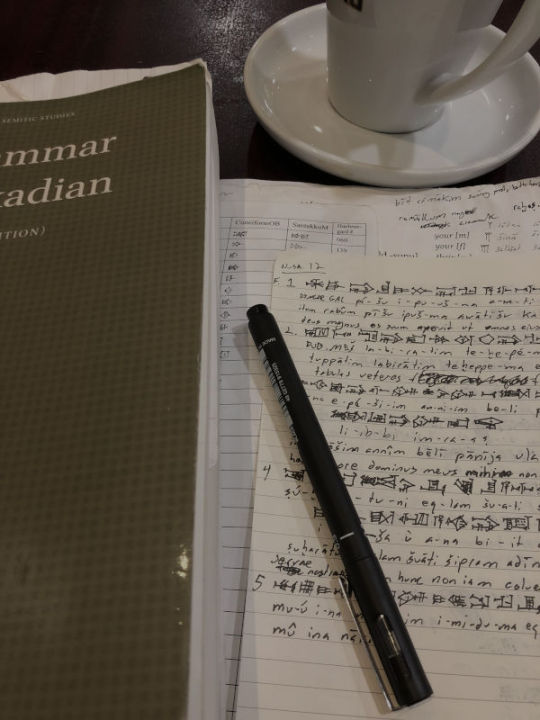



Before class the other day : studies near Russell square and bizarre clouds over London.
#no amount of filters will make that classroom look aesthetic#I should really bring Caplice with me if I'm going to take pictures#the blue cover looks so much better in photos#dark academia#dark acadamia aesthetic#grey academia#books#book photography#studyblr#study blog#akkadian#cuneiform#london#bloomsbury#russell square#coffee#coffee shop#ἐποίησα
44 notes
·
View notes
Text
"Blackbird" translated into the Akkadian (Ancient Babylonian) language (inspired by this lovely lute version)
Aškikītum ṣalmum tātallal- Blackbird, thou singest,
Kappīkī ḫepātim išî u ṣubbibī- Bear your broken wings and flutter,
Kala napištīkī- All your life,
Ūmum annûm tattaqî- You have waited for this day,
Šērtum ellētum qî- Wait for the holy morning.
Aškikītum ṣalmum tātallal- Blackbird, thou singest,
Atti uznīkī ṣalmūtim petî- Open your two black eyes,
Kala napištīkī - All your life,
Ūmum annûm tattaqî- You have waited for this day,
Anumma putaṭṭerī - Now be released.
Aškikītum- Bird,
Itaṣbibī- Fly
Aškikītum- Bird,
Itaṣbibī- Fly
Ina nannār burūmim- Into the light of the sky
Aškikītum- Bird,
Itaṣbibī- Fly
Aškikītum- Bird,
Itaṣbibī- Fly
Ina nannār ermiānim- Into the light of Anu’s canopy,
Aškikītum ṣalmum tātallal- Blackbird, thou singest,
Kappīkī ḫepātim išî u ṣubbibī- Bear your broken wings and flutter,
Kala napištīkī- All your life,
Ūmum annûm tattaqî- You have waited for this day,
Anumma putaṭṭerī - Now be released.
Ūmum annûm tattaqî- You have waited for this day,
Anumma putaṭṭerī - Now be released.
Ūmum annûm tattaqî- You have waited for this day,
Anumma putaṭṭerī - Now be released.
Ao3
14 notes
·
View notes
Text


honestly i (or more likely someone else with actual experience and skill) could feasibly make this in actual copper and written in actual cuneiform, like it took me less than five minutes to find strips of quarter inch wide copper for sale on etsy that i bet i could bang into a bracelet*, i just gotta figure out how to do cuneiform and find a good direct line from one of the tablets to write
*and then it took me about an hour and a half to find a record of one of ea-nasir's complaints with both the phonetic reading and translation compared line by line and a key showing each cuneiform character and their phonetic reading and then turn it into this:

the cuneiform part would be what i'd write on the bracelet
#honestly tho i was so excited looking at this until i realized it was written in english w/ a font meant to look like cuneiform 🤢#just write it in Akkadian cuneiform it would 1) look cooler and 2) be funnier#i'm not gonna fault tumblr for using rose gold bc copper oxidizes but i will judge them for that ugly font#Top Tino Post#ea nasir#santagno
92 notes
·
View notes
Text
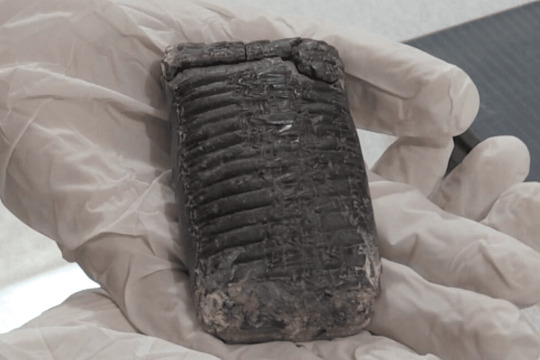
3,800-Year-Old Cuneiform Clay Tablet Found in Turkey
Archeologists have discovered a 3,800-year-old cuneiform clay tablet in southern Turkiye during restoration work after the massive earthquakes in the region earlier this year, Anadolu reported today.
Murat Akar, an archeology professor at Hatay Mustafa Kemal University, said a 25-member team found the clay tablet with cuneiform inscription in Akkadian language in nearly 4,000-year-old Accana tumulus in the southern Hatay province.
The Kahramanmaras-centred twin earthquakes on 6 February, which caused great destruction in Hatay, also affected the historical site, which was determined to be the location of Alalakh, the capital of the Mukish Kingdom during the Middle and Late Bronze Age periods.
Restoration and protection work have started with the leadership of the Turkish Culture and Tourism Ministry to repair the damages on some parts of the ruins of palace walls, Akar said.
As part of the study, the team that removed the rubble of the walls found a clay tablet among the ruins.
The first examination of the tablet in Akkadian language revealed information containing an agreement made by Yarim-Lim, the first known king of Alalakh, to purchase another city.
Akar said the tablet is not damaged and the finding was “so exciting.”
“It proves to us that those kings had the economic power and potential to buy another city in those times. There is also the name of the important people of the city who witnessed this sale on the tablet, most likely,” he added.
“The work came out as an extremely unique example, especially to decipher the economic structure of that period, the relationship between cities, the economic and political model,” Akar said.
The tablet will be transferred to a museum after the examinations, the head of the restoration team said.



#3800-Year-Old Cuneiform Clay Tablet Found in Turkey#Yarim-Lim#king of Alalakh#Akkadian language#ancient artifacts#archeology#archeolgst#history#history news#ancient history#ancient culture#ancient civilizations
52 notes
·
View notes
Text

Akkadian cuneiform foundation cone (clay, c. 1934-1924 BC)
The inscription: I, Lipit-Ishtar, the humble shepherd of Nippur, true farmer of Ur, unceasing (provider) for Eridu, lord suitable for Uruk, king of Isin, king of the land of Sumer and Akkad, favourite of the goddess Ishtar, fashioned a pair of pot stands, a gift (for) the arms of the gods Enlil and Ninlil, in Isin, the city of my kingship, at the palace gate, when I, Lipit-Ishtar, son of the god Enlil, had established justice in the land of Sumer and Akkad.
image and adapted text from here
8 notes
·
View notes
Text

Because Ugaritic is a Semitic Abjad it can be used to write Hebrew, so you can now write Hebrew in a Cuneiform script! (like this)
(Hebrew is written right-to-left, but Ugaritic is left-to-right.)
א : 𐎀
ב : 𐎁
ג : 𐎂
ד : 𐎄
ה : 𐎅
ו : 𐎆
ז : 𐎇
ח : 𐎈
ט : 𐎉
י : 𐎊
ך : 𐎋
כ : 𐎋
ל : 𐎍
ם : 𐎎
מ : 𐎎
ן : 𐎐
נ : 𐎐
ס : 𐎒
ע : 𐎓
ף : 𐎔
פ : 𐎔
ץ : 𐎕
צ : 𐎕
ק : 𐎖
ר : 𐎗
ש : 𐎌
ת : 𐎚
(word separator) : 𐎟
You can transcribe any Hebrew text automatically at this site, just pick Hebrew on the left and Ugaritic on the right.
Exodus 34:1
ויאמר יהוה אל־משה פסל־לך שני־לחת אבנים כראשנים וכתבתי על־הלחת את־הדברים אשר היו על־הלחת הראשנים אשר שברת׃
𐎆𐎊𐎀𐎎𐎗𐎟𐎊𐎅𐎆𐎅𐎟𐎀𐎍𐎎𐎌𐎅𐎟𐎔𐎒𐎍𐎍𐎋𐎟𐎌𐎐𐎊𐎍𐎈𐎚𐎟𐎀𐎁𐎐𐎊𐎎𐎟𐎋𐎗𐎀𐎌𐎐𐎊𐎎𐎟𐎆𐎋𐎚𐎁𐎚𐎊𐎟𐎓𐎍𐎅𐎍𐎈𐎚𐎟𐎀𐎚𐎅𐎄𐎁𐎗𐎊𐎎𐎟𐎀𐎌𐎗𐎟𐎅𐎊𐎆𐎟𐎓𐎍𐎅𐎍𐎈𐎚𐎟𐎅𐎗𐎀𐎌𐎐𐎊𐎎𐎟𐎀𐎌𐎗𐎟𐎌𐎁𐎗𐎚
#hebrew#semitic#cuneiform#babylonian#akkadian#ancient#mesopotamia#jewish#judaism#canaanite#phoenician#assyrian#aramaic
7 notes
·
View notes
Text
A 3,800-year-old Akkadian cuneiform tablet was found during the archaeological excavations carried out in the Aççana Mound, the old city of Alalakh, in the Reyhanlı district of Hatay city in southern Turkey.
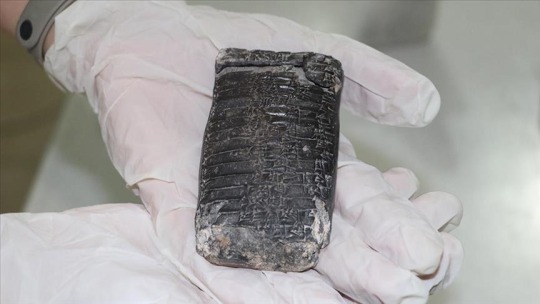

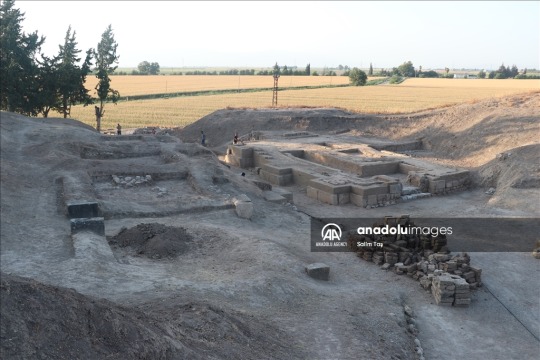
Removing the wall rubble as part of the study, the team found a cuneiform clay tablet among the remains.
In the first examination of the Akkadian tablet, information regarding the agreement made by Yarim-Lim, the first known king of Alalakh, to buy another city was found.
Akar emphasized that the tablet found among the remains, dating back 3,800 years, is in a well-preserved form. "While removing the debris of a few collapsed walls at the mound, it was very exciting to come across a tablet that had never been touched or damaged," he said.
Akar continued by stating that the historical period of the artifact extends to the Middle Bronze Age. "During the Middle Bronze Age, a period we define as such, we observe that the kings of this region possessed economic power. This is evidenced by astonishing examples documented in written records. In this tablet, we see that Yarim-Lim, the first known king of Alalakh, intended to purchase another city and, in this regard, entered into an agreement. This actually demonstrates that the kings in this region had the economic capability and potential to acquire another city," he said.
Assoc. Prof. Dr. Akar, who pointed out that the tablet would also contribute to understanding the economic structure of the era, stated,
"The tablet likely contains the names of significant individuals from the city who witnessed this sale. In a sense, we see evidence of a witness list from that period,"
"The work came out as an extremely unique example, especially to decipher the economic structure of that period, the relationship between cities, and the economic and political model," he said.
47 notes
·
View notes
Text

Above is the clay Cyrus Cylinder, an Ancient Iranian document, written in clay, dating from the 6th century BC. Written in Akkadian cuneiform, it documents some of the ideas of Persia's king, Cyrus the Great, including some astoundingly far-sighted ideas on human rights.
For instance, Cyrus guaranteed freedom of religion, nearly twenty three centuries before John Locke had similar notions, and abolished slavery, some twenty four centuries prior to William Wilberforce.
#Cyrus Cylinder#Antiquity#history#historical#Persia#Iran#Akkadian#cuneiform#clay#human rights#academia
7 notes
·
View notes
Note
silim! i’m struggling trying to figure out how to write enemy (kur2) in akkadian cuneiform. the main source i’m using (an akkadian handbook, miller and shipp) says that it’s kur2, which i can find the sign for. however, i’ve also seen it as nu-kur-te. would it just be the kur2 sign or would it be nu-kur-te? also, do you have any recs for books or websites to understand how signs actually work? i’m very interested but also very confused lol. thank you so much!
Hi! The answer is that Akkadian is complicated. Akkadian is generally written with borrowed Sumerian signs at its core, in this case the Sumerian sign kur2 "enemy, hostile person; to be different, strange, foreign", 𒉽 in cuneiform. This is the sign used as the base form of the Akkadian word nakāru 𒉽 "enemy, to be foreign", which is actually not etymologically related to Sumerian kur, instead being from Proto-Semitic and related to terms like the modern Arabic nakira "to ignore", though probably influenced by the similar-sounding Sumerian word. The parallel Akkadian word nakru "enemy, foreign" is written 𒇽𒉽 in cuneiform, equivalent to Sumerian lu2-kur2 "enemy person".
However, Akkadian has a very different grammar from Sumerian, and so was often written with a Sumerian base form but with added signs to indicate prefixes, suffixes etc. So how exactly the word would be written varies a lot by how it appears in a sentence - nukurte may be a specific verb conjugation. My Akkadian grammar isn't very strong, so if an Akkadianist out there can identify the specific form here or can clarify this word's conjugation/declension, that would be great!
10 notes
·
View notes
Text
𒁾𒁇𒊏𒀝𒁴
𒁹𒁀𒇷𒎙𒄿𒍠𒃼𒋃𒉘𒊭𒌋𒅗𒁾𒀭𒀝𒌝𒈠𒅅𒉈
𒁹 𒄀𒌈 𒆪𒌦𒉡𒌈𒊭𒌓𒁲𒆪𒌦𒈝
𒈫 𒊭𒅋𒇺𒅖𒌅𒊭𒊭𒊭𒀊𒆷𒎙𒅇𒊭𒊭𒀊𒆷𒎙𒅖𒌅𒊭𒅋𒇺𒋰𒊏𒀀𒌅𒅖𒋼𒉏𒅁𒁍𒍑
𒐈 𒆠𒈠𒄢𒆷𒌈𒅖𒌅𒅖𒋼𒉏
𒐂 𒀜𒁕𒉌𒀭𒌓𒌋𒂼𒉌𒀭𒌍
𒐊 𒂵𒂵𒀸𒅔𒃼𒋛𒋗𒅖𒋛𒄿𒎗𒅁𒌈𒅔𒃼𒋛𒊭𒄿𒁁𒅕
𒑁 𒆠𒈠𒂵𒂵𒉘𒅔𒊭𒌉𒆸𒂊𒁉𒅕𒅔𒂊𒈬𒊌𒂊𒈬𒄄
𒑂 𒅍𒀀𒈾𒀭𒎌𒅖𒌅𒆠𒁴𒌋𒀀𒈾𒊬𒆧𒁴𒊭𒊭𒀊𒆷𒎙𒅇𒅋𒇺𒄿𒉿
#akkadian#ancient languages#babylonian#cuneiform#mesopotamia#semitic languages#assyriology#ancient#emerald tablet#hermeticism#hermetica
22 notes
·
View notes
Text
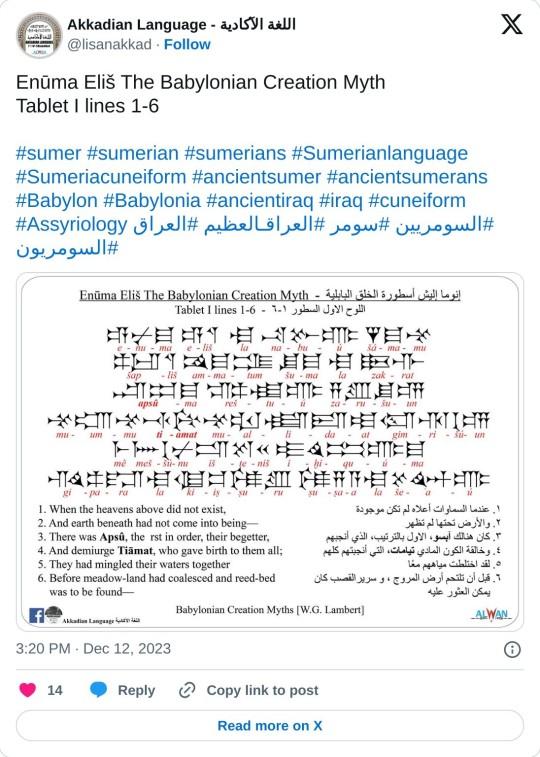
#sumer#sumerian#sumerians#Sumerianlanguage#Sumeriacuneiform#ancientsumer#ancientsumerans#Babylon#Babylonia#ancientiraq#iraq#cuneiform#Assyriology#العراق#العراقـالعظيم#سومر#السومريين#ancient#Akkadian Language#Enūma Eliš#Myth#hmm...
7 notes
·
View notes
